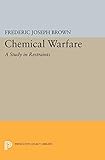Chemical Warfare : A Study in Restraints / Frederic Joseph Brown.
Material type: TextSeries: Princeton Legacy Library ; 2119Publisher: Princeton, NJ : Princeton University Press, [2015]Copyright date: ©1968Description: 1 online resource (376 p.)Content type:
TextSeries: Princeton Legacy Library ; 2119Publisher: Princeton, NJ : Princeton University Press, [2015]Copyright date: ©1968Description: 1 online resource (376 p.)Content type: - 9780691622378
- 9781400876952
- 350/.895
- UG447
- online - DeGruyter
- Issued also in print.
| Item type | Current library | Call number | URL | Status | Notes | Barcode | |
|---|---|---|---|---|---|---|---|
 eBook
eBook
|
Biblioteca "Angelicum" Pont. Univ. S.Tommaso d'Aquino Nuvola online | online - DeGruyter (Browse shelf(Opens below)) | Online access | Not for loan (Accesso limitato) | Accesso per gli utenti autorizzati / Access for authorized users | (dgr)9781400876952 |
Frontmatter -- ACKNOWLEDGEMENTS -- CONTENTS -- LIST OF TABLES -- INTRODUCTION -- PART I. WORLD WAR I -- INTRODUCTION -- 1. THE HERITAGE OF WAR -- PART II. THE INTERWAR YEARS -- INTRODUCTION -- 2. THE AFTERMATH OF WAR -- 3. THE EVOLUTION OF POLICY, 1922-1939 -- 4. RESTRAINTS AT THE OUTBREAK OF WAR -- PART III. THE TEST OF WORLD WAR II -- INTRODUCTION -- 5. CONFIRMATION OF RESTRAINTS 1939-1942 -- 6. THE CRUCIAL TEST-MID-1945 -- 7. SUMMARY AND CONCLUSIONS -- GLOSSARY OF ABBREVIATIONS -- BIBLIOGRAPHY -- INDEX
restricted access online access with authorization star
http://purl.org/coar/access_right/c_16ec
Why would a nation, in the midst of a vicious and unrestricted war, hesitate to employ a weapon guaranteed to inflict massive casualties on the enemy? Major Frederic Brown offers here the first critical analysis of this curious World War II phenomenon. He investigates the nature of restraints-political, military, economic, and psychological-operative in varying degrees between 1919 and 1945, when U.S. chemical warfare policy was being formed. Starting with the experiences of toxic agent use during World War I, Major Brown shows how various restraints to gas warfare developed during the inter-war years. He then discusses the World War II experience. In the conclusion Major Brown relates his findings to contemporary conflicts and offers important implications for the future of the cold war.Originally published in 1968.The Princeton Legacy Library uses the latest print-on-demand technology to again make available previously out-of-print books from the distinguished backlist of Princeton University Press. These editions preserve the original texts of these important books while presenting them in durable paperback and hardcover editions. The goal of the Princeton Legacy Library is to vastly increase access to the rich scholarly heritage found in the thousands of books published by Princeton University Press since its founding in 1905.
Issued also in print.
Mode of access: Internet via World Wide Web.
In English.
Description based on online resource; title from PDF title page (publisher's Web site, viewed 30. Aug 2021)


